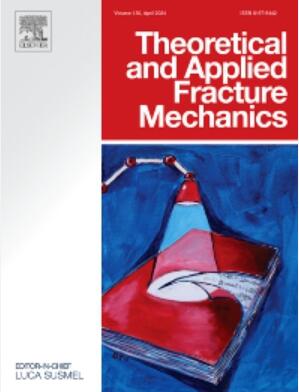The characteristics of hydraulic fracture morphology in glutenite reservoirs: An experimental investigation
IF 5.6
2区 工程技术
Q1 ENGINEERING, MECHANICAL
引用次数: 0
Abstract
Hydraulic fracturing efficiently unlocks the vast energy potential of glutenite, a crucial unconventional tight oil/gas reservoir. However, the characteristics of the hydraulic fracture (HF) morphology is complex and remains unclear in highly heterogeneous glutenite reservoirs. It is challenging to design fracturing schemes effectively. In this work, rock mechanics experiments and ten groups of true triaxial hydraulic fracturing experiments were carried out to investigate the HF morphology. Critical factors such as horizontal stress difference (HSD), injection rate, fluid viscosity, gravel volume content, and gravel size were investigated. Based on computed tomography (CT) scanning technology, this work innovatively established a three-dimensional fracture characterization method in glutenite samples to observe fracture morphology. The results indicate that in glutenite reservoirs, the initiation positions of HF typically exhibit randomness, often occurring at multiple asymmetric points. The propagation directions of HF are influenced by both HSD and formation heterogeneity, frequently deviating from the direction of the maximum principal stress. The propagation behavior of HF encountering gravel mainly manifests as penetration and deflection. These behaviors are co-controlled by the penetration capability of HF and the shielding effect of gravel. Furthermore, under conditions of low HSD, high injection rate, low fluid viscosity, and large gravel size, HF morphology is more complex, with a high tendency to generate branched fractures. The initiation pressure is positively correlated with HSD, injection rate, and fracturing fluid viscosity, and negatively correlated with gravel content. This study provides a theoretical basis for the optimization of fracturing designs in glutenite reservoirs.
糯质岩储层水力压裂形态特征:实验研究
水力压裂法能有效地释放糯辉岩--一种重要的非常规致密油气藏--的巨大能量潜力。然而,水力压裂(HF)形态特征非常复杂,在高度异质的糯质岩储层中仍不明确。有效设计压裂方案具有挑战性。在这项工作中,进行了岩石力学实验和十组真正的三轴水力压裂实验,以研究 HF 形态。研究了水平应力差(HSD)、注入率、流体粘度、砾石体积含量和砾石尺寸等关键因素。基于计算机断层扫描(CT)技术,该研究创新性地建立了一种三维裂缝表征方法,用于观察糯辉岩样品的裂缝形态。结果表明,在谷朊岩储层中,高频的起始位置通常表现出随机性,经常出现在多个不对称点上。高频的传播方向受到 HSD 和地层异质性的影响,经常偏离最大主应力的方向。高频遇到砾石时的传播行为主要表现为穿透和偏转。这些行为由高频的穿透能力和砾石的屏蔽效应共同控制。此外,在低 HSD、高注入率、低流体粘度和大粒径砾石条件下,高频形态更为复杂,极易产生分支裂缝。起始压力与 HSD、注入率和压裂液粘度呈正相关,与砾石含量呈负相关。这项研究为优化糯质岩储层的压裂设计提供了理论依据。
本文章由计算机程序翻译,如有差异,请以英文原文为准。
求助全文
约1分钟内获得全文
求助全文
来源期刊

Theoretical and Applied Fracture Mechanics
工程技术-工程:机械
CiteScore
8.40
自引率
18.90%
发文量
435
审稿时长
37 days
期刊介绍:
Theoretical and Applied Fracture Mechanics'' aims & scopes have been re-designed to cover both the theoretical, applied, and numerical aspects associated with those cracking related phenomena taking place, at a micro-, meso-, and macroscopic level, in materials/components/structures of any kind.
The journal aims to cover the cracking/mechanical behaviour of materials/components/structures in those situations involving both time-independent and time-dependent system of external forces/moments (such as, for instance, quasi-static, impulsive, impact, blasting, creep, contact, and fatigue loading). Since, under the above circumstances, the mechanical behaviour of cracked materials/components/structures is also affected by the environmental conditions, the journal would consider also those theoretical/experimental research works investigating the effect of external variables such as, for instance, the effect of corrosive environments as well as of high/low-temperature.
 求助内容:
求助内容: 应助结果提醒方式:
应助结果提醒方式:


